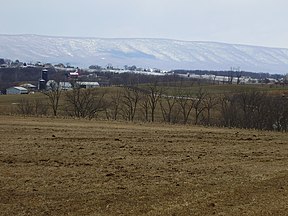| Blue Mountain[2] | |
|---|---|
Kittatinny Mountain (and nine others:
| |
 The "Great Wall" of the Blue Mountain in Pennsylvania in February 2008 | |
| Highest point | |
| Peak | Clarks Knob in Franklin County, Pennsylvania 2,320 feet (710 m)[5] |
| Elevation | 1,129 ft (344 m)[2] |
| Coordinates | 40°07′28″N 77°39′59″W / 40.12444°N 77.66639°W |
| Dimensions | |
| Length | 150 mi (240 km) northeast-southwest to SSW 150 miles (240 km) (direct aerial) 255 miles (410 km) trace of ridgeline, including loops back[4] width = varies along chain's length |
| Geography | |
| Country | United States |
| State | Pennsylvania |
| Borders on | Ridge-and-Valley Appalachians and Great Appalachian Valley |
| Geology | |
| Orogeny | Appalachian Mountains |
| Age of rock | Silurian |
| Type of rock | Tuscarora Formation and Shawangunk Formation; sedimentary |
Blue Mountain, Blue Mountain Ridge, or the Blue Mountains of Pennsylvania is a ridge of the Appalachian Mountains in eastern Pennsylvania. Forming the southern and eastern edge of the Ridge-and-Valley Appalachians physiographic province in Pennsylvania, Blue Mountain extends 150 miles (240 km) from the Delaware Water Gap on the New Jersey border in the east to Big Gap in Franklin County in south-central Pennsylvania at its southwestern end.
Views of Blue Mountain dominate the southern tier of most eastern and central Pennsylvania counties, providing an ever-visible backdrop cutting across the northern or western horizon. Most transport corridors and road beds piercing the barrier necessarily pass through large water gaps, including (west to east) the Susquehanna, Schuylkill, Lehigh and Delaware River valleys or wind gaps, low gaps in the ridge caused by ancient watercourses. The barrier ridge forms a distinct boundary between a number of Pennsylvania's geographical and cultural regions.
To the south of the Susquehanna River gap in the south-central part of the state is the Cumberland Valley, part of the Great Appalachian Valley; to its northwest side are the southern reaches of the Susquehanna Valley with picturesque streams channeling travel corridors deep into and over the central and western mountains and valleys—the heartland interior counties of Pennsylvania; along the Main Branch Susquehanna, the valleys also lead into the Coal Region of northeast Pennsylvania, the Wyoming Valley, and the distant Poconos. To the south of Blue Mountain lies the Capital Region of Harrisburg and nearby communities, the rich farming country of the Lebanon Valley and Pennsylvania Dutch Country of York and Lancaster counties, the lower half of the Lehigh Valley, and the lower Delaware Valley, both of which extend north through water gaps beyond the ridgeline.
Blue Mountain School District, which is named after the mountain range, is located just off PA Route 61 in Schuylkill Haven, Pennsylvania.
- ^ "Blue Ridge Mountain". Geographic Names Information System. United States Geological Survey, United States Department of the Interior. Retrieved 2017-03-29.
Blue Ridge Mountain 1169893 Summit Wyoming PA 413628N 0760535W 1171 Meshoppen - 02-AUG-1979
- ^ a b c "Blue Mountain". Geographic Names Information System. United States Geological Survey, United States Department of the Interior. Retrieved 2009-02-07.
1193708 Name: Blue Mountain 40.1245315 -77.6663793 400728N 0773959W Roxbury
- ^ What's in a name, Spanning the Gap newsletter of the Delaware Water Gap National Recreation Area, Summer 1984
- ^ Measured along ridge point by point using maps.google.com ruler tool, anchored on New Jersey border, to Maryland border., 29 March 2017.
- ^ "Clarks Knob". Geographic Names Information System. United States Geological Survey, United States Department of the Interior. Retrieved 2009-02-08.


